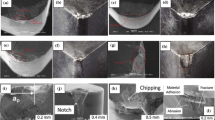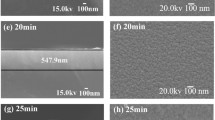Abstract
The machining of depleted uranium and its alloys are discussed in this article. Traditionally, these materials have been machined, with limited success, using uncoated cutting tools. New developments in titanium-based coatings such as cation-substituted Ti1-x-y-z Al x Cr y Y2N alloys, with y=0.03 and z=0.02, have been shown to offer enhanced high-temperature oxidation resistance compared with the presently used TiN and Ti1-x Al x N films that are deposited to cutting tool surfaces. Layers (3 µm thickness) were deposited by unbalanced magnetron sputter (UBM) deposition to small-grain WC-Co unused cutting tools that had been ion-etched in situ using a steered Cr-metal-ion cathodic arc (CA) discharge at an Ar pressure of 6 × 10−4 mbar (0.45 m Torr). The metal ion etching promoted initial local epitaxy on individual substrate grains while the overall film texture evolved through competitive growth to a (111) plane in Ti0.44Al0.53Cr0.03N alloys and (200) plane in Ti0.43Al0.52Cr0.03Y0.02N alloys. Although Ti0.04Al0.53Cr0.03N layers exhibited a columnar microstructure that was similar to that previously observed in Ti1-x Al x N alloys, the addition of 2 mol% YN resulted in significant grain refinement, giving rise to an equiaxed structure. The Knoop microhardness of Ti0.43Al0.52Cr0.03Y0.02N alloys was HK0.025=2700 kg/mm compared with 2400 kg/mm for Ti0.44Al0.53Cr0.03N alloys. The onset of rapid oxidation, as determined from thermogravimetric measurements, ranged from ≈600 °C for TiN; to 870 °C for Ti0.466Al0.54N; to 920 °C for Ti0.44Al0.53Cr0.03N; to 950 °C for Ti0.43Al0.522Cr0.03Y0.02N. Machining experiments indicated that cutting tool life is improved significantly using Y-doped Ti-based coatings when machining uranium alloys.
Similar content being viewed by others
References
Tool Wear, Modern Metal Cutting: A Practical Handbook, Sandvik-Coromant, 1994, p 1–27
J.A. Aris, Machining of Uranium and Uranium Alloys, Machining, Vol 16, ASM Handbook (formerly, Metals Handbook, 9th ed.), ASM International, 1989, p 874–878
O. Knotek, M. Böhmer, and T. Leyendecker, Structure and Properties of Ti and Al Hard Compound Films, J. Vac. Sci. Technol., A, 1986, 4, p 2695–2710
H. Jehn, S. Hofmann, V.-E. Rückborn, and W.-D. Münz, Morphology and Properties of Sputter (Ti,Al) N Layers on High-Speed Steel as a Function of Deposition Temperature and Sputtering Atmosphere, J. Vac. Sci. Technol., A, 1986, 4, p 2701–2705
W.-D. Münz, TiAlN Films: An Alternative to TiN Coatings, J. Vac. Sci. Technol., A, 1986, 4, p 2717–2725
G. Håkansson, J.-E. Sundgren, D. McIntyre, J.E. Greene, and W.-D. Münz, Microstructure and Physical Properties of Polycrystalline Metastable Ti0.5Al0.5N Alloys Grown by d.c. Magnetron Sputter Deposition, Thin Solid Films, 1987, 153, p 55–62
D. McIntyre, J.E. Greene, G. Håkansson, J.-E. Sundgren, and W.-D. Münz, Oxidation of Metastable Single Phase Polycrystalline Ti0.5Al0.5N Films, J. Appl. Phys., 1990, 67, p 1542–1553
W.-D. Münz, Oxidation Resistance of Hard Wear Resistant Ti0.5Al0.5N Coatings Grown by Magnetron Sputtering Deposition, Werkstoffe Korros., 1990, 41, p 753–754
W.-D. Münz, D. Schulze, and F.J.M. Hauzer, A New Method for Hard Coatings: Arc Bond Sputtering, Surf. Coat. Technol., 1992, 50, p 169–178
I. Petrov, P. Losbichler, D. Bergstrom, J.E. Greene, W.-D. Münz, T. Hurkmans, and T. Trinh, Large Scale Fabrication of Hard Superlattice Films by Combined Stress Arc Evaporated Unbalanced Magnetron Sputtering, Thin Solid Films, 1997, 302, p 179–192
W.-D. Münz, I.J. Smith, D.B. Lewis, and S. Creasey, Droplet Formation on Steel Substrates During Cathodic Arc Steered Metal Ion Etching, Vacuum, 1997, 48, p 473–481
J.W. Colby, Qauntex-ray Instruction Manual, Kevex, Foster City, CA, 1980
JCPDS International Center for Powder Diffraction Data, Powder Diffraction File for TiN [6-642], JCPDS International Center for Powder Diffraction Data, Swarthmore, PA, 1989
I. Petrov, L. Hultman, U. Helmersson, J.-E. Sundgren, and J.E. Greene, A Newly Developed Ion Implanter for Industrial Applications, Thin Solid Films, 1989, 169, p 299–314
F. Adibi, I. Petrov, L. Hultman, U. Wahlström, T. Shimizu, D. McIntyre, J.E. Greene, and J.-E. Sundgren, Low Energy Ion Irradiation During Growth of TiN, J. Appl. Phys., 1991, 69, p 6437–6450
VDI-Richtlinien 3198, Beschichten von Werkzeugen der Kkaltmassivumformung, Beuth Verlag, Berlin, Germany, 1992
M. Kronenberg, Machining Science and Application, Pergamon Press, Oxford, U.K., 1996
Author information
Authors and Affiliations
Rights and permissions
About this article
Cite this article
Jackson, M.J., Robinson, G.M. Machining of depleted uranium using coated cutting tools. J. of Materi Eng and Perform 15, 161–171 (2006). https://doi.org/10.1361/105994906X95814
Received:
Revised:
Issue Date:
DOI: https://doi.org/10.1361/105994906X95814




